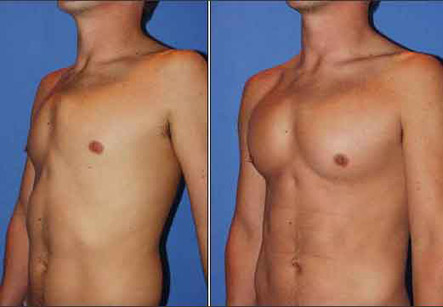Male Breast Implants
Introduction
Male breast implants are becoming popular as they are increasingly demanded by people with altered way of life. Male breast implants are particularly used for giving better appearance and presentation in following groups of people:
1. Female impersonators
2. Cross dressers or transvestites
3. Gender benders
4. Male to female transsexuals
The breast implantation is also useful in body builders and regularly exercising people who are not able to develop their chest muscles known as pectoral muscles. This is known as pectoral augmentation or chest implants for men. This surgery helps in improving the appearance of chest muscles making them more bulky and projecting.
However, the common purpose of males for getting this surgery done is to obtain the look of a woman.
The techniques for males breast augmentation is similar to that performed in female breast implantation. The only difference in the breast implant is it has dissimilar size and contours which addresses for the natural biological differences between a male and female body. However, the entire procedure is usually the same.
Many times, the plastic surgeons are reluctant for performing male breast augmentation possibly because of social and legal reasons. Therefore, declaration of gender to the plastic surgeon is very important before undergoing the procedure.
Males sometimes undergo breast augmentation without gender reassignment

First consultation:
The patient is able to resume his work within a few days, depending on the physical activity involved.
It is very important to discuss the steps of the surgery, the procedures done before and after surgery as well as risks of the procedure in detail. This is done because any surgery is a major decision whether cosmetic or therapeutic.
The surgeon decides about whether the patient is a candidate for surgery or not. The success of the augmentation depends on skill and experience of the surgeon as well as the surgeon’s ability to foresee the possible results.
During first consultation, the surgeon instructs the patient about how to prepare for the surgery. This is as follows:
Before the surgery
1. A proper history, examination and few lab tests and scans are done to determine the general health.
2. The suitable implant selected after evaluation of male breast and also the musculature of chest is ordered and sterilised on the day before the surgery. Ice packs are kept ready.
3. Patient should stop anti-inflammatory drugs like aspirin at least a week before surgery.
4. Medications being taken for other conditions like diabetes, heart disease, blood pressure should be continued with advice from the treating doctor.
5. History of smoking or alcohol drinking should be told to the surgeon. Smoking should be stopped if possible as it interferes with the wound healing.
6. Recent history of cough, cold, fever, viral infections, or other illnesses should be informed to the surgeon.
7. Patient is not allowed to eat or drink anything at least 8 to 12 hours before surgery except essential medicines with sips of water.
8. A consent form is signed by the patient regarding the procedure and risks of surgery.
The procedure:
Breast implant options include:
1. Saline breast implants: Filled with sterile salt water.
2. Silicone filled breast implants: Filled with soft, elastic gel. They require a longer incision for implant placement.
Incisions for breast implants:
Under general anaesthesia, an incision can be made just above the lower crease of the breast tissue, around the lower edge of the areola or within the armpit.
After the incision, the surgeon creates a pocket of tissues into which the implant is inserted. This pocket is made either directly behind the breast tissue or underneath the pectoral muscle. After this, hemostasis or control of blood loss is achieved, drains are put and incision is closed by a special technique to make it very inconspicuous.
After the surgery:
1. The next two days after the surgery should be a period of rest, as the patient feels tired and sore.
2. Within a few days of surgery, the dressings and drains applied during surgery are removed. Usually 10 days are required to remove the sutures or stitches. A surgical brassiere is prescribed to the patient to help in the recovery.
3. It commonly takes three to five weeks for the swelling in the breasts to disappear.
4. The patient is able to resume his work within a few days, depending on the physical activity involved.
5. The breasts are usually sensitive to direct stimulation for two to three weeks following the surgery. The soreness and discomfort in the breasts disappears in about four weeks.
Risks:
1. Bleeding
2. Infection
3. Discomfort
4. Anaesthesia related problems in breathing and allergies to medications